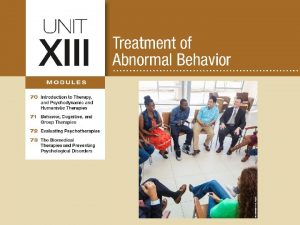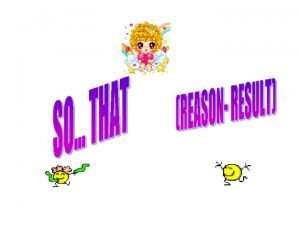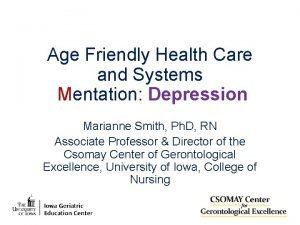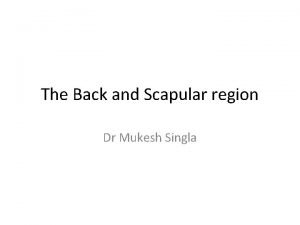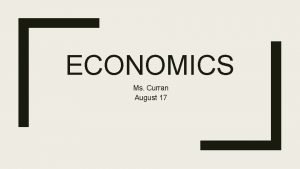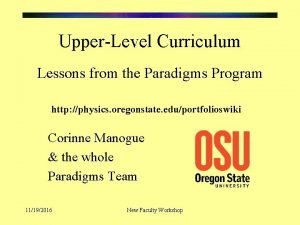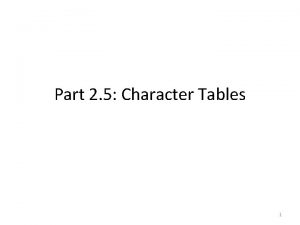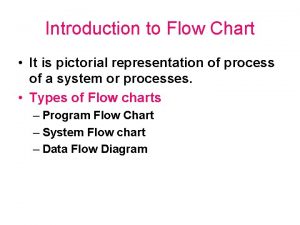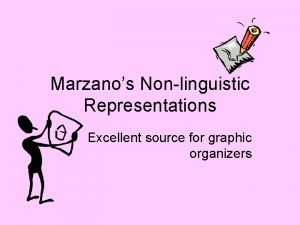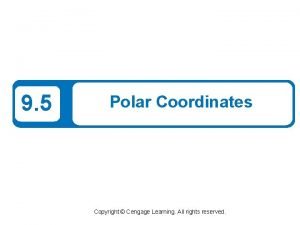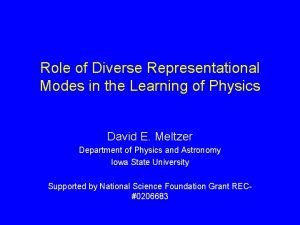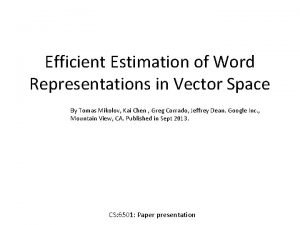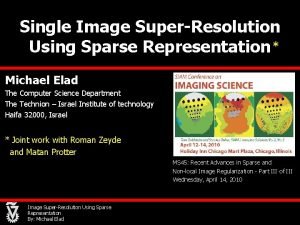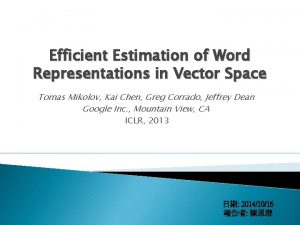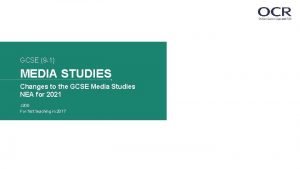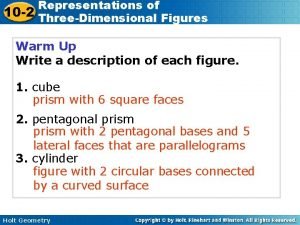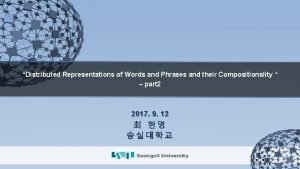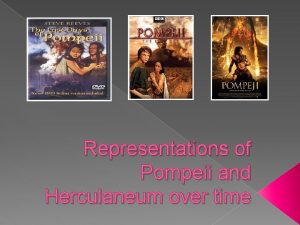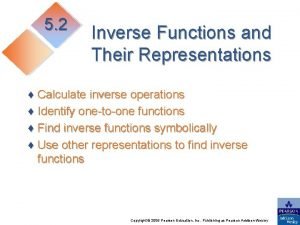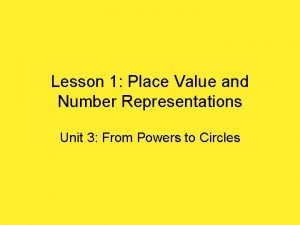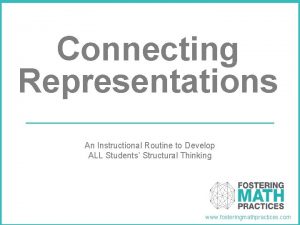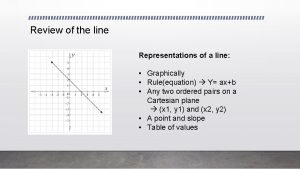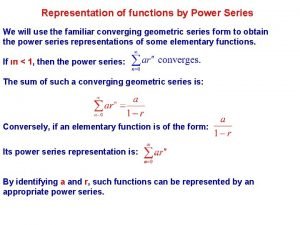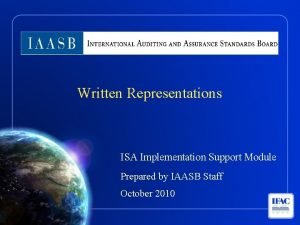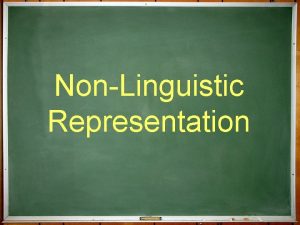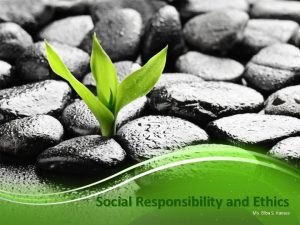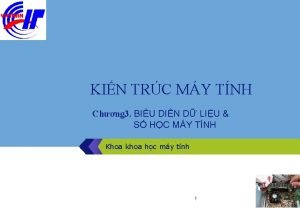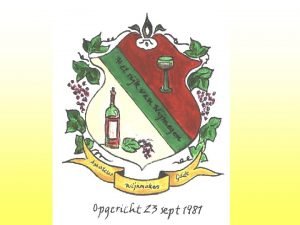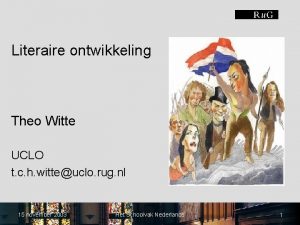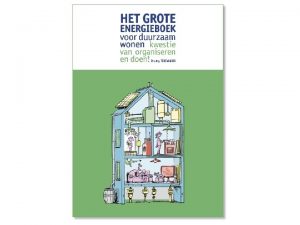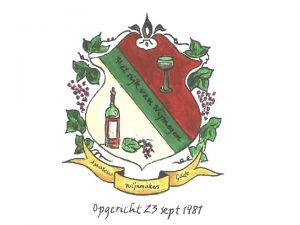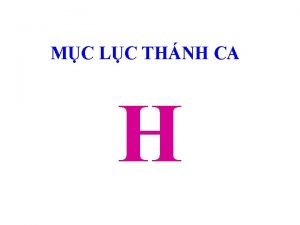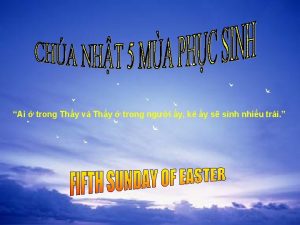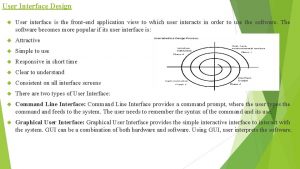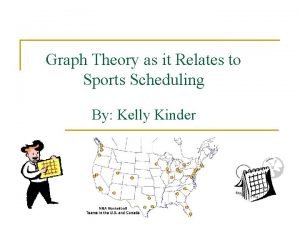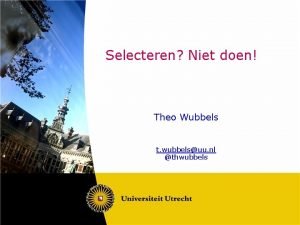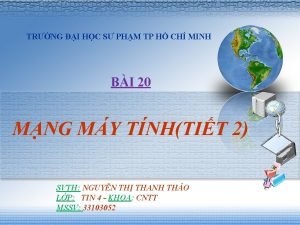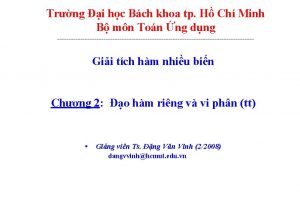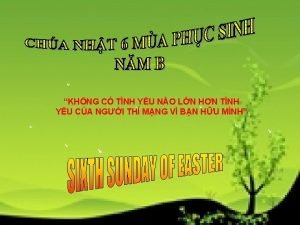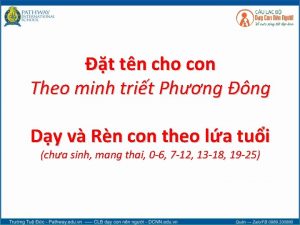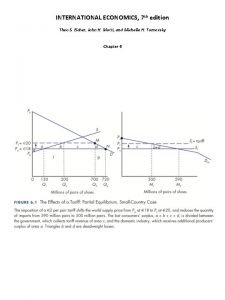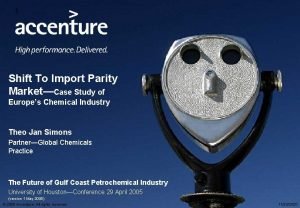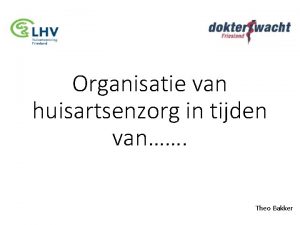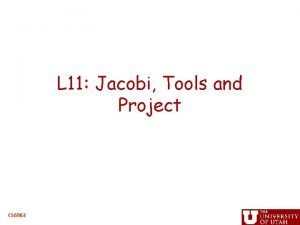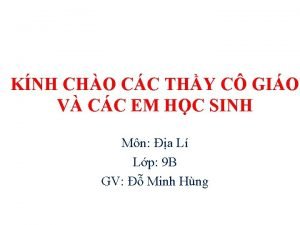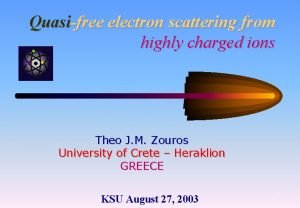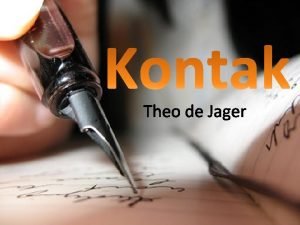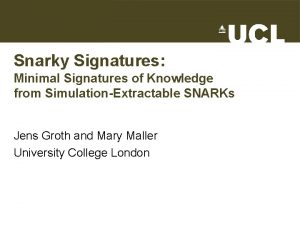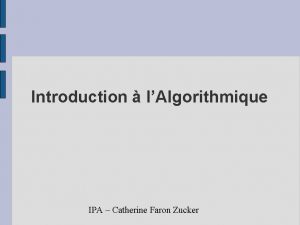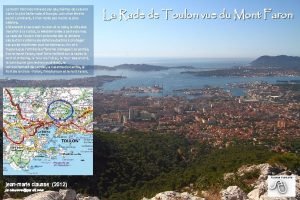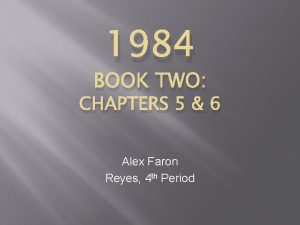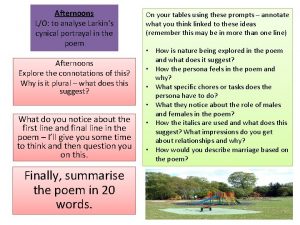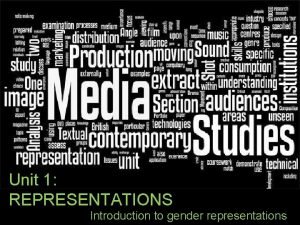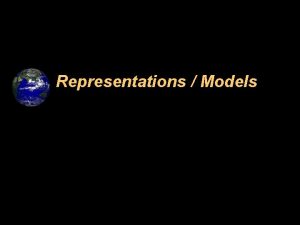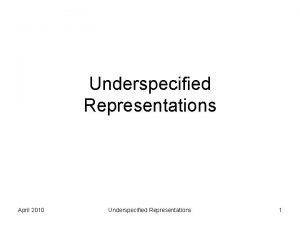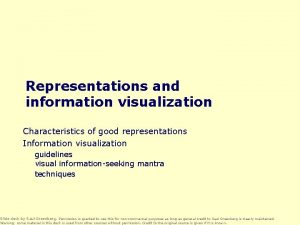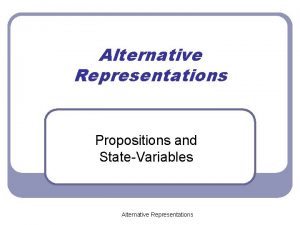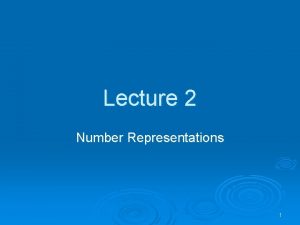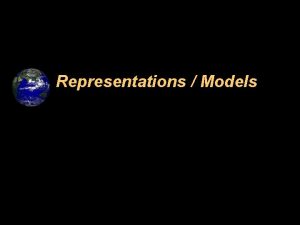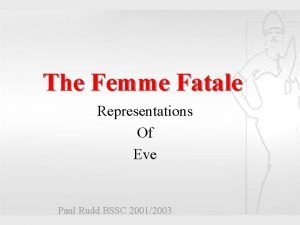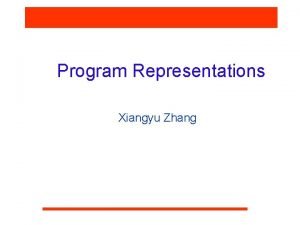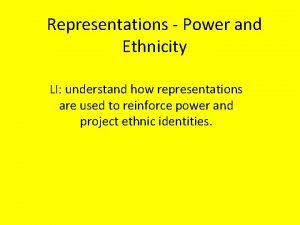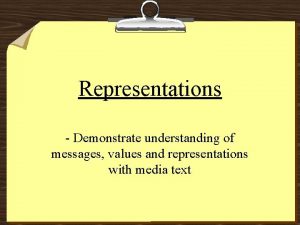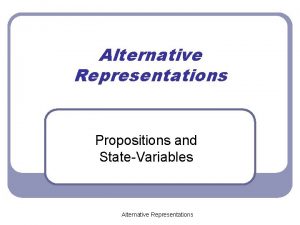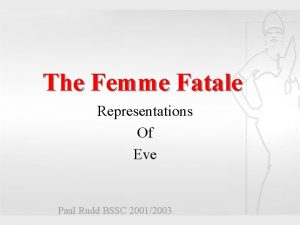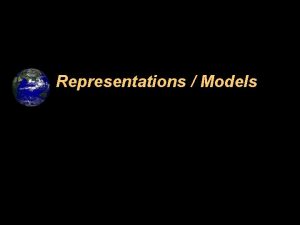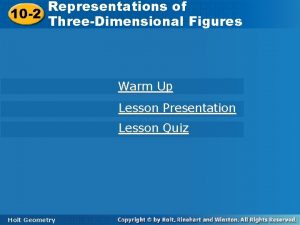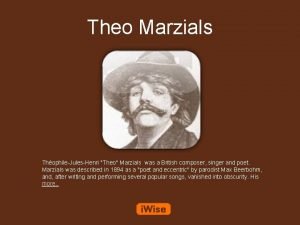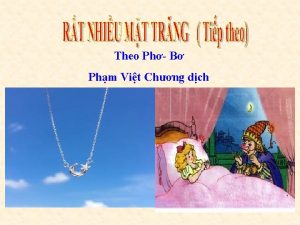Theo Faron Representations of Theo CYNICAL SNARKY DEPRESSED























































- Slides: 55

Theo Faron

Representations of Theo CYNICAL SNARKY DEPRESSED

• Cynical - At the beginning of the film when baby Diego dies, Theo uses other people’s feelings to guilt his boss into letting him take the rest of the day off of work. • Snarky - Throughout the film we see Theo snap and make harsh comments about other characters and groups in the film. • Depressed - We rarely see Theo smile, the only time we truly see him smile is when Kee gives birth to her child. Perhaps due to Britain being such a gloomy, uninspiring society

ALCOHOLIC ILLEGAL DRUG USER PESSIMISTIC

• Alcoholic - We see Theo pouring whiskey straight into his coffee in the morning right before he goes to work. We also see him in the ark of the arts scene putting his whiskey bottle into the security box. This shows that he is an alcoholic as he always has a bottle of whiskey with him. • Illegal drug user - Theo comes home from his work so that he can go visit his friend. When he arrives at his friends house we see them smoking a joint together. This shows that he is an illegal drug user as weed is an illegal drug • Pessimist - Seems to have lost all hope for the future ahead and this is reflected into his primarily negative approach towards current events.

• Throughout the film, Theo is always dressed in dark clothing, this represents his dark character and personality. This also represents the dark nature of his society. • Theo looks dirty and unshaven which emphasises the dystopian environment in society and the fact that society is hopeless. This also shows that Theo is always on the run or in trouble.

• Throughout the film, we don’t see many positive emotions from Theo as he always seems to be in a bad mood. He always seems to either be angry, upset or scared and doesn’t often seem happy or excited. This emphasises the affect that the dystopian world is having on the public.

• At the start of the film when Theo and Kee are introduced they are not very fond or interested in each other. Theo is very laid back and doesn't seem to be bothered whereas Kee seems very uptight and judgemental towards him. • As the film progresses and he finds out about the fact that Kee is pregnant and then finds out about Luke’s plan he begins to develop a protective father like role towards her and does all he can to make sure that she and the baby are safe.

Theo’s Ideology • From the start of the film, Theo represents pessimists and realists. In the coffee shop at the start of the film he completely ignores everyone else who is enthralled by the report of Baby Diego’s death and the news report itself. • This shows his pessimistic behaviour as he has accepted that there is no hope in the world and nothing can change that and has chosen to continue with his life without caring about anything that has such significance. • This is also shown by the way he skips off work to smoke drugs with his only friend, Jasper

• As the film progresses, Theo gradually changes. The change is most felt in the Fishes’ safe house when he discovered that Kee is pregnant. This causes the change as he had always felt that there was no hope because of the world-wide infertility crisis and the revelation that she is pregnant restores hope in him that a cure can be found. • While he has changed to have a more optimistic outlook, he is still a realist as he is well aware of the dangers of facing both the Fishes and the British government.

• Theo’s actions and inactions could also be a reflection of the filmmakers ideology and what they think is valuable in a person. • Theo represents a more Liberal ideology while Luke and the Fishes represent Utilitarianism viewpoints with Luke wanting to start a revolution, involving Kee’s baby as the focal point. • Theo tends to deal in the moment without thinking on how his actions could affect the future. Although it could be argued that by helping Kee get to the Human Project, Theo helps deal with the infertility crisis. • He also helps those around him and those he knows (rather than helping with the Fishes revolution attempt that could help millions of people) as shown by the way he helps his ex-girlfriend move an illegal immigrant without asking about why she needs to be moved.

• By the end of the film, it can be argued that Theo has changed from a pessimist to a complete optimist. • This can be shown by the fact that Theo, despite the very low chance of survival, he goes into Bex Hill in order to escape Britain and get to the Human Projects boat. • He risks his life attempting to get Kee back mainly because he has hope that Kee’s baby may be able to end the infertility crisis.

Representation Immigrants

Portrayal “Fugi” slur Blamed for terrorism Threats of deportation Implied Kee would not be allowed to keep child since she is a fugitive Seen being held in cages Borders closed for eight years Warning signs against hiding immigrants – “please report suspicious behaviour”

• Portrayal in Society • Being a fugitive is shown as bad, they use “fugi” as a slur. • When the bomb goes off, they are blamed showing that Immigrants are a hated scapegoat. • Borders have been closed for eight years yet deportation is still implied showing that illegal immigrants are a big, continuous problem. • The Fishes tell Kee that as she is a fugitive the Government would take her baby away so that the first child in eighteen years would be seen as British. • As he is making his way to Jasper’s house Theo passes a containment unit full of Immigrants. They are all standing, close together in a cage like structure. This portrays them as lesser humans. • Throughout the main city of London there are signs on the buildings and buses that say “Please report any suspicious behaviour. ” This shows that the media is constantly highlighting immigrants and those who help immigrants as bad.

Arrival We security which looks strict and high demand Theo is pushed around and told where/what to do for the first time in the filmwe see the rules which stand here and what Bexhill will be like Concentration camp stylecolour and lighting and crowds of people standing with guards in complete control Guns everywhere so the audience know this place is armed Miriam is escorted from the bus on arrival- this shocks audience Loud and scary environment where everyone struggles to hear over the shouting and echoed sounds when arriving

• Theo, Miriam, and Kee’s Arrival at Bexhill • The security is very high going in with many barriers and guards all of whom are armed and look strict. • The lighting, colours and set up is very similar to that of a concentration camp with lots of people crowded in a small space and guards being in control. • Miriam is taken off of the bus and it is implied she is killed (we see a bag going over head and then bodies with similar bags). When that happens people are shouting and it shows how chaotic and dangerous Bexhill is. This shocks the audience • It is a loud and scary environment with everybody shouting over one another and the voices echoing. • Theo is pushed and ordered around for the first time in the film. This highlights that even assumed fugitives do not get any rights there. Theo loses his control over the situation and this highlights a change in the rules of the world in “Children of Men”.

Colours are muted and barecold and Britain is a clear representation here People in Bexhill look are desperate and their appearance is shabby and dirty- clothing are all neutral and military like colours. A place with no rules or disciplinepeople are wild and don’t care about Bexhill as a place anymore Bexhill Government destroying Bexhill Somewhat a modern shanty town Missiles seen at end means no respect for immigrant life

• Bexhill • All the people in Bexhill look desperate, their clothes are shabby and dirty. Anything they wear is in neutral and even military colours. This shows that they are meant to be seen as an underdog in terms of their abilities but that they are also other fighters against the Government. • The colours of the actual buildings are all very dull and the people look cold. It is meant to be a shanty town however by this lack of colour it makes it clear that the film is in Britain as elsewhere there would be more colour and different materials. • There is talk of the Government trying to destroy Bexhill, this is confirmed when in the end a missile is seen going over Kee and Theo’s boat towards Bexhill. This highlights a lack of care about immigrant life. • The riots seen by the immigrants show Bexhill to be a place without rules and where people don’t care about it anymore. This mirrors what people in the film think about Immigrants, no one cares and people can do what they like to them.

Marichka Changes audience’s view on immigrants Looks after dogs (stays for them) Cares for Kee and Baby Little bit mad Romanian Speaks no English Leads Theo and Kee to boat Traps Syd Layers of clothing

• Marichka’s actress is Romanian and so the character is assumed to be the same. This shows how different the types of immigrants are who need help (Kee is African). She is not seen to speak English but does seem to understand showing the lack of education that an immigrant is given but also highlights their capabilities as people. • This is the first time that the audience sees an immigrant who has been detained. She is different from how they are portrayed in the society and so makes us feel sympathetic to her and the others. • She makes us feel sympathetic by doing good deeds; she gives Kee and Theo a place to deliver the baby, she traps Syd so that he cannot hurt them and leads them to the boat. This shows extreme compassion making us changes our views on immigrants in the film. • When she refuses a space on the boat so that her dogs are not left alone we see them as good people who care. Animals are used in film to make us like normally unlikable characters. Usually it would be hard to like Marichka as there is limited communication. However her connection to the dogs makes this easier. • Marichka is seen to be wearing many layers of clothes including a colourful red jacket which highlights her as important. These clothes make it seem like the immigrants need to take all they can with them at every moment and need warmth.

cultures • Romanian = seen in Marichka and other women • Muslim = seen in protesters shouting Islamic quotes • African = seen in Kee

• Cultures • Marichka and the other women who tend to Kee and the Baby are portrayed as Romanian. Islamic protestors are seen in the street identified by the shouting of Muslim phrases as they walk towards the fight. Kee herself who is an immigrant is assumed to be African. • These places are all different in cultures and geographically showing the wide range of people that have been affected by the wars and new world

Ideology • If you describe/analyse representations please make sure you discuss what ideologies they present as part of your response. • Immigrants are people. • What the Government says isn’t always the truth. • They need help from others, not just being sent back to where they came from.

• Ideology • The immigrants are shown differently throughout the film but what the film is trying to tell the audience is; • Immigrants are people capable of doing things just like the rest of us such as going through difficult situations and still helping others. • What the Government says about groups of people isn’t often true and we need to be aware of media propaganda. • Sending immigrants back to where they came from won’t help anyone, they need our help otherwise they wouldn’t have came here.

Children Of Men Representation of the British Society/ Government

OPENING SEQUENCE

Britain / Government • The opening sequence deals with disappointment and violence. Theo starts off by getting a cup of coffee in a shop where a news report is telling the audience all the terrible things that are happening in this new dystopian world. When he leaves the coffee shop we see militant helicopters above innocent civilians showing a world at war. We witness a terrorist attack in the coffee shop that shows society is dangerous and corrupt. Soon after this everyone gets on with their normal lives showing that this is a regular occurrence in British society.

ARK OF ARTS SEQUENCE

Britain / Government • When Theo is travelling to get the transit papers from the government building he is in a Bentley. This is a great contradiction to the other people in society who are travelling in tuc’s. This represents the concentrated wealth gathered in a minority by the corrupt government who appear to have lost all humanity as they let their people live in squalor. The camera follows the Bentley showing how powerful it is which relates to the power of the government. The song by Court of the Crimson King is also very important in this scene as it is about rebellion of the people from a fascist government which is what is happening in the film.

Britain / Government • The government building is very clean and has a high control level security which shows fascism. The building itself is very fascist as there is a massive poster of the crown, this greatly contrasts to the out of control world surrounding the building. • The gate Theo passes through is a physical barrier between rich and poor showing the government are people who would rather protect precious art work than the people in its society. • The fact that the Ark of arts is extremely clean, large and organised giving a sense of control and power from the government. This contrasts to the outside world as London is dirty, disorganised and dangerous.

ARRIVING AT BEXHILL

Britain / Government • When Kee, Theo and Miriam arrive at bexhill the audience is shocked by the horrible way people are treated. In the scene we see strict surveillance from Britain’s arm. This along with the fact people are kept in cages makes it looks like we arriving at a concentration camp of such. When they arrive the immigrants are treated like animals. They are hit, pushed about and shot. It is particularly upsetting for the audience when Miriam is killed seemingly without thought, conscience or reason. This portrays the government as an unfeeling machine rather than the people who are helping a failing society which is what a government’s role actually is.

BATTLE OF BEXHILL

Britain / Government • There is a plethora of violence in the Bexhill sequence which could result in males/ adults being more attracted to this film. In this scene we see more fighting between the fishes and the government showing their clear regard for human life and both equally as corrupt as each other.

LEAVING BEXHILL

Britain / Government • When leaving Bexhill we as the audience are relieved. We then see a good side of society in the human project who eventually approach Kee, Theo and Dylan and we assume that they are offered help.

Britain / Government IDEOLOGY • The film is trying to tell us that the government is locked away behind armed guards and barriers, it is separated from its people and keeps all the money for themselves. This shows us that the film has a left wing ideology and believes that without equality the world would become ruined. The way the government treats immigrants shows they are also portraying fascism as wrong. • Society is conveyed as ruined if left to its owned devices. It is not strong enough to deal with a disaster.

Children of Men: Luke and the Fishes Lewis B, Lewis S, Hamish, Arran and Holly

Luke, the Fishes and Morality • The preferred reading of the Fishes from ‘Children of Men’ is their morality is grey. Their ideals are very similar to that of Theo. They takes things in a more violent way. This is illustrated when Luke murders Jasper and the Fishes execute a civilian.

• The preferred reading of the Fishes from ‘Children of Men’ would be that they are morally grey terrorists who wish to overthrow the British government through a violent revolution. Their ideals are very similar to that of Theo, but their pseudo leader Luke takes things in a more violent militaristic and brutal utilitarian manner. This is illustrated when Luke murders Jasper unnecessarily. This sense of violence is carried over when members of the Fishes execute a civilian in the battle of Bexhill when they attempted to help Theo and Kee.

Luke, the Fishes and Morality (Continued) • The Fishes are against the Government. They could be seen as a force of good. They want to kill Theo as he found out their plans, not because he is a villain.

• It could be argued that the actions of The Fishes are for Justice against the Government. In a way the Fishes could be perceived as a force of good fighting against the dictatorial British Government. The only reason they are attempting to kill Theo is that he managed to get in the way of the Fishes, overhearing about them killing Julian, hearing about them planning to execute him, escaping and hiding with Miriam and Kee, etc.

Luke's Character Luke as a character is a false hero. He fits this character role as he begins the film as a ‘good’ character, while later he reveals his true intentions and becomes more violent. Despite this he shares many similar ideas to Theo, yet is more violent.

• Luke as a character fits the false hero archetype. He fits this character role as he begins the film as a ‘good’ character, while later on in the film after the coup to kill Julian, he reveals his true intentions and becomes a villain of sorts. Despite this, he is still a false hero as he shares many similar ideas to Theo, yet he takes a more violent and radical approach to accomplishing his goals.

The Fishes (Differential) The Fishes are an anti government group who want equal rights for immigrants. They are a violent group who are willing to execute people who oppose them to accomplish their goals. The preferred reading of the Fishes is that they are a morally grey. The audience is made to dislike aspects of them, yet applaud other aspects.

• The Fishes are an anti government rebel group who want equal rights for immigrants attempting to get into Britain. They are a violent group who are willing to execute people who oppose them and are willing to partake in all out war(Bexhill) to accomplish their goals. The preferred reading of the Fishes is that they are a morally grey group who are neither good nor evil. The audience is made to dislike aspects of them, yet applaud other aspects. Their violent campaign and executions show unpleasant parts of their character, yet their opposition of the fascist British government is something that audiences can support.

Who are the Fishes? • Julian, leader and Theo’s ex wife • Luke, leader after Julian's death • Miriam, Kee’s helper/midwife • Patrick, Luke's attack dog

Why the name Fishes? • In ancient times an underground Christian organization used the symbol of a fish as a way to identify themselves. As they were against the establishment this can be associated with the Fishes in Children of Men. In the original novel the fishes were considerably more religious. Although this was changed in the film, the fish symbol was carried on.

An image of the Fishes


WOMEN IN CHILDREN OF MEN

REPRESENTATION OF JULIAN: She is a strong woman who is a brave leader of rebel group, the Fishes, who want to overthrow the fascist government. She is stubborn and caring as she helps smuggle an immigrant across the country. She is the dispatcher in terms of the Hero’s Journey and convinces Theo to help them get Kee out of the country safely. IDEOLOGY: The fact that she is killed and is replaced by Luke shows that leadership is patriarchal. There also no evidence of same sex couples which shows the opinion of the director. She is a tragic leader, who is undermined by Luke who clearly thinks men are better than women. During the car chase scene when she is killed, she shouts “cover Kee!” so this shows she is selfless and the audience immediately has sympathy for Julian when she is sacrificed for Kee’s safety.

REPRESENTATION OF KEE: She is vulnerable as she is dependant on other people taking charge and taking her through the country. Despite being in need from protection, Kee is boisterous and can speak her mind when she wants to, e. g. when she spat in Luke’s face when she realised his motives and swearing upon meeting Theo. IDEOLOGY: Kee takes on the role of the princess from Propp's character roles, even though Kee has a huge part in the movie, she isn’t highly regarded as a main character. The book originally had Julian having the baby, but the director wanted to reinforce theory of humanity deriving from Africa and this is why Kee was chosen to have the baby, as she symbolises bringing humanity back.

REPRESENTATION OF MIRIAM: Spiritual woman who is Buddhist, she is part of the Fishes, midwife, linked to motherhood IDEOLOGY: The director included Miriam to add a motherly touch to the movie, Miriam is caring and kind and is the midwife, a stereotypical woman role, linked to babies and nurturing.
 Module 70 introduction to therapy
Module 70 introduction to therapy Gutter fracture
Gutter fracture We had ... horrible day that we felt depressed
We had ... horrible day that we felt depressed Depressed mentation
Depressed mentation Depress scapula muscles
Depress scapula muscles Simplified representations of complex economic activities
Simplified representations of complex economic activities Multiple representations
Multiple representations Cultural representations and signifying practices
Cultural representations and signifying practices Mulliken symbols
Mulliken symbols Flow chart is a pictorial representation of
Flow chart is a pictorial representation of Marzano nonlinguistic representation
Marzano nonlinguistic representation Multiple representations of polar coordinates
Multiple representations of polar coordinates Multiple representations
Multiple representations Efficient estimation of word representation in vector space
Efficient estimation of word representation in vector space Map work mathematical literacy pdf
Map work mathematical literacy pdf On single image scale-up using sparse-representations
On single image scale-up using sparse-representations Mathematical literacy grade 11 maps and plans
Mathematical literacy grade 11 maps and plans Efficient estimation of word representations
Efficient estimation of word representations Unit 1: media representations mark scheme
Unit 1: media representations mark scheme Representations of three dimensional figures
Representations of three dimensional figures Distributed representations of words
Distributed representations of words Types of maps in mathematical literacy
Types of maps in mathematical literacy Pompeii logo
Pompeii logo Functions and their representations
Functions and their representations Place value representations
Place value representations Connecting representations
Connecting representations Representations of a line
Representations of a line Representations of functions as power series
Representations of functions as power series Isa 580 written representations summary
Isa 580 written representations summary Maps, plans and other representations of the physical world
Maps, plans and other representations of the physical world What is nonlinguistic representation
What is nonlinguistic representation Macrs là gì
Macrs là gì Theo chocolate makes a sweet difference
Theo chocolate makes a sweet difference Biểu diễn số chấm động
Biểu diễn số chấm động Theo jacobi
Theo jacobi Theo witte
Theo witte Theo timmers
Theo timmers Theo jacobi
Theo jacobi Chữ y
Chữ y Vì chúa yêu tôi nên tôi theo gót ngài
Vì chúa yêu tôi nên tôi theo gót ngài Bài trích phúc âm theo thánh gioan
Bài trích phúc âm theo thánh gioan User interface analysis
User interface analysis Teor nba qq theo
Teor nba qq theo Theo wubbels
Theo wubbels Theo góc độ địa lý mạng máy tính
Theo góc độ địa lý mạng máy tính Khai triển taylor hàm 2 biến
Khai triển taylor hàm 2 biến Thinhnam net lien_he_gop_y
Thinhnam net lien_he_gop_y Môi trường tam bảo
Môi trường tam bảo Theo eicher
Theo eicher Theo jan simons
Theo jan simons Theo bakker huisarts
Theo bakker huisarts Theo jacobi
Theo jacobi Tỷ lệ tăng tự nhiên
Tỷ lệ tăng tự nhiên Schönebecker aue wanderweg
Schönebecker aue wanderweg Theo ion
Theo ion Theo de jager biography
Theo de jager biography
